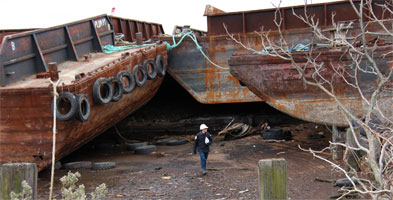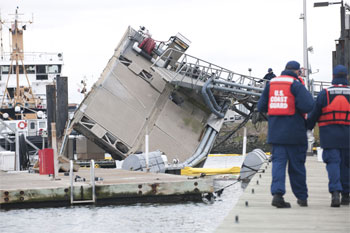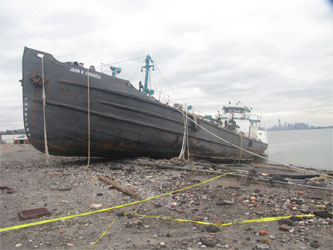Hurricane Sandy, the killer Northeast superstorm, caused more damage to the region’s maritime industry than any disaster in memory, mariners said.
The combined tropical cyclone and nor’easter took dead aim at New York Harbor and closed ports from Florida to southern New England. The Oct. 29-30 landfall beached vessels, demolished piers, flooded quay-side offices and ruined cargo.
Two people were killed off North Carolina when the tall ship HMS Bounty tried to sail around the brunt of the largest Atlantic hurricane on record.
 |
|
Courtesy U.S. Coast Guard The superstorm lifted barges up onto the shoreline at South Amboy, N.J. |
The Port of New York and New Jersey was totally closed for about two days after Sandy’s departure while the U.S. Coast Guard assessed navigation channels and boatyards picked up the pieces. Counting the pre-storm preparatory closure that began Oct. 28, the waterways were not fully open for almost a week.
“It was a mess, believe me,” said Capt. Dennis Wheeler, the Sandy Hook Pilots’ New York vice president. “Everything was picked up by the surge and dropped right down when the surge receded. Our dock was pretty much trashed, and we had five feet of water in our shop.”
The magnitude of the storm’s wrath caught some people off guard. Most weather forecasts warned of a six- to 12-foot storm surge around New York. The surge turned out to be 13 to 14 feet. The force of the rising seawater piled barges on top of each other, destroyed a 51-foot-tall lighthouse and deposited a 185-foot tanker ship onto a city street.
It took a few days for the towing industry to gather itself, said Weeks Marine’s Rudy Wohl, chairman of the port’s Maritime Association Tug & Barge Committee. Facing severe gasoline shortages, politicians insisted that fuel tanker traffic be given first priority to enter the harbor. Tugboats needed to wait for the Vessel Traffic Service to grant permission to move.
“There was a tremendous amount of floating debris and things that got sunk that were identified as hazards to navigation that needed to be cleared,” Wohl said. “There were a few days of limited sailing and limited travel times, but mostly the Coast Guard did a good job of getting waters back up for commerce.”
Wohl said Weeks Marine had flooded dock equipment on its Jersey City, N.J., pier, and “getting people in and out of the facility was a challenge.”
Harley Marine NY, whose homeport is the Brooklyn Navy Yard, had about $100,000 in damage but none to vessels, said General Manager John Walls. Extra mooring lines held, he said. The naval yard was still operating on backup power in December.
 |
|
Courtesy U.S. Coast Guard Coast Guard pollution responders assess damage to a pier in Bayonne, N.J., after Hurricane Sandy departed the area. |
“Even though the water was 10 to 12 feet where our pier is, our tugs and barges fared well,” Walls said. “Our trailer office, support facilities and dock equipment were not so fortunate.”
Equipment and instrumentation at the Staten Island Ferry slips and the Hoboken ferry terminal were damaged. Staten Island Ferry service was suspended for 72 hours.
Sandy destroyed the Coast Guard’s boat docks and gutted buildings at Station New York on Staten Island and flooded out much of the station in Sandy Hook, N.J. Some Staten Island-based vessels were relocated to Bayonne, N.J. A mobile dock was set up in Sandy Hook.
Capt. Gordon Loebl, captain of the port of New York and New Jersey, said the harbor was fortunate that the Coast Guard sector had just completed an update to its hurricane disaster plan in September. As the storm approached, port stakeholders participated in daily conference calls. The Coast Guard ordered all ships out to sea by 1700 on Oct. 28.
Loebl said he initially wanted the Arthur Kill vertical lift railroad bridge to be left in the raised position for the duration of the storm. If it got stuck in that position, then ships could still transit it. The rail operators balked, and a compromise was reached whereby the bridge would remain lowered, with a Captain of the Port order insisting that bridge personnel remain with their lift mechanism on Staten Island.
After the storm, pollution responses commenced. The National Oceanic and Atmospheric Administration’s hydrographic survey vessel Thomas Jefferson helped the pilot boat New York and the Coast Guard and Army Corps of Engineers inspect the waterways for obstructions. Displaced aids to navigation were put back on station.
The Coast Guard opened the port to shallow-draft commercial barge traffic Nov. 1. Three days later, the port was opened to all commercial traffic, with one “no wake” restriction.
Tanker, bulk and container deliveries continued to suffer, though, because of the inability of the docks to accept them. Ships were diverted to other regions, including Virginia’s Hampton Roads, and cargo volume tripled at the Port of Halifax.
“The real problem was the (lack of) electrical power at the shore-side facilities,” said Loebl.
Steve Coleman, spokesman for the Port Authority of New York and New Jersey, said the saltwater surge destroyed 16,000 new automobiles. One containership remained docked at the New York Container Terminal because of a propulsion problem but was not damaged by Sandy.
“There was no major damage to berths,” Coleman said. “A lot of the problem was damage that came as a result of the flooding that knocked containers around, and the power disruption was a major issue for at least a week.”
The waterways surveys revealed that most aids to navigation fared well. A glaring exception was Old Orchard Shoal Lighthouse, which was swept away. The 51-foot-tall, cast-iron sparkplug-style beacon had stood for 119 years in Lower New York Bay near Staten Island.
“I guess the surge just basically undermined the structure completely, and it was built on rock,” Wheeler said. “The whole lighthouse just disappeared into the bay. Amazing.”
Sandy pounded and partially crumbled a Staten Island pier where the abandoned coastwise tanker John B. Caddell was moored. The 185-foot vessel broke loose, and the storm surge dropped it down onto a city street. The vessel’s starboard fuel tank leaked, and oily water filled the engine room. Chief Petty Officer Bo Lisenby, a Mobile, Ala.-based oil-pollution responder who was the first member of the Coast Guard’s National Strike Force to board the stranded tanker, said its moorings had been strengthened in preparation for the hurricane.
“Water is an amazing thing. Water can do anything,” Lisenby said. “If you take an entire bay of water, it can push a ship up and take it wherever it wants. Luckily, she didn’t get out in the bay very far.”
A Donjon Marine crane barge refloated John B. Caddell in December. The future of the 71-year-old former World War II yard oiler is in doubt. The Coast Guard said its last known owner, a foreign national who had planned to move the single-hulled vessel to Nigeria, died recently. It was previously registered to Poling & Cutler Marine Transport Co. of New York, according to documents that expired in April 2011.
As he gazed out over the harbor from the deck of John B. Caddell, Lisenby said the hurricane’s economic price tag cannot account for the suffering, considering that the storm killed more than 250 people.
“The damage that occurred, there’s really no way to put a dollar number on the misery,” Lisenby said, shaking his head. “Very unfortunate.”
Three weeks after the storm, to aid commuters, New York City established a temporary fast-ferry service between the south shore of Staten Island and Manhattan. New York Water Taxi won the contract.
In December, the Tug & Barge Committee held a meeting with New York and federal officials. Mariners were among the first to respond to Sandy by salvaging and repairing waterfront infrastructure. Capt. Eric Johansson, the committee’s executive director, said the yards now need assistance with permits, zoning and financing to restore their own facilities.

